How to quickly write pages to increase sales
(By the way, to get articles like this free in your inbox, subscribe to our newsletter.)
—includes the “vital few” copywriting techniques that have the greatest impact on profits.
Everything you need to quickly create incredibly effective pages, sales scripts, videos, and emails
We are obsessive about copywriting. We have read almost every copywriting resource you can name, and we have applied and tested hundreds of techniques, on the world’s most successful websites.
Here’s what you’ll get from the following slides, video, and transcript:
- The “vital few” most powerful copywriting techniques on which to focus. They aren’t the most fun or interesting, but they are the most effective—and provide a good framework on which to focus your time and energy.
- On Slides 28–35, an excellent template you can use to rapidly create winning sales messages to sell any product—in any format, including landing pages, sales scripts, videos, and emails.
The slides
A video of the talk
If you already know our company’s back-story, skip to the 5:14-minute mark.
The talk in podcast format
To download the audio of this talk, and others, subscribe to our podcast.
Resources mentioned during the talk
Screen-recording software
Feedback software
The mechanics of writing well
- The Elements of Style, a book by William Strunk Jr. and E.B. White.
- Professional Writing Style, an online guide to some advanced aspects of grammar and style.
- Free guides from the Plain English Campaign.
A transcript of the webinar (edited to make it more readable)
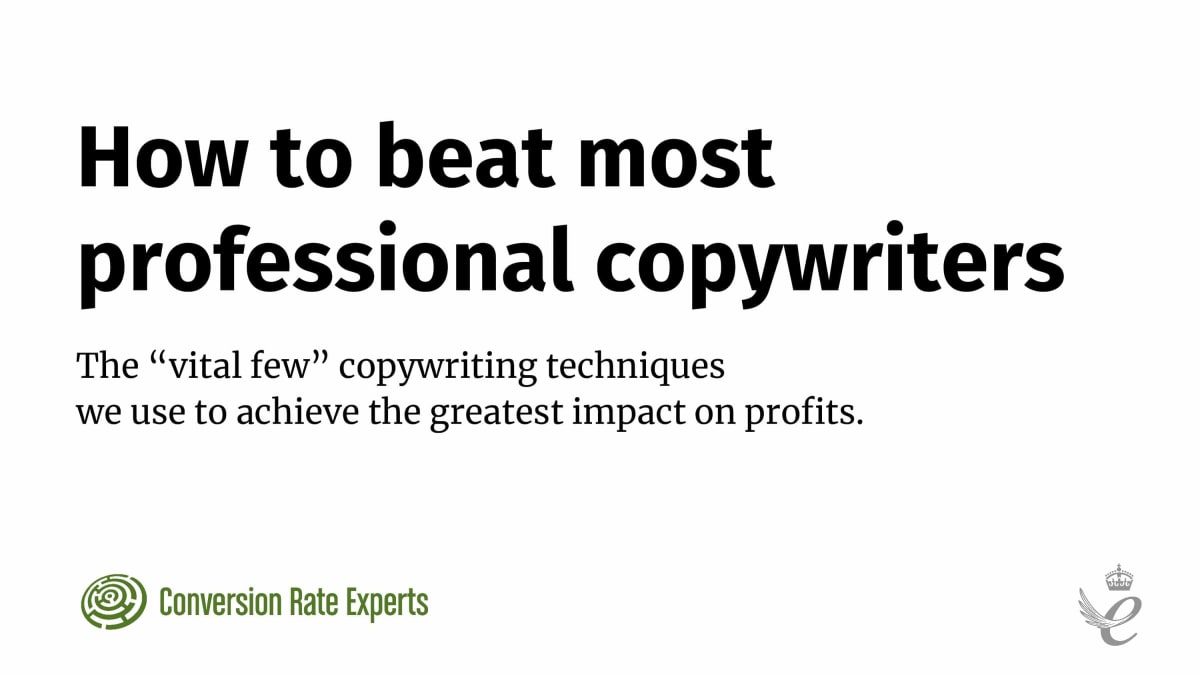
Today’s webinar is about how to beat most professional copywriters, and the vital few copywriting techniques we use to achieve the greatest impact on profits. I’m Dr. Karl Blanks from Conversion Rate Experts. During the call, if you have any questions, we’ll try to answer them.
First, I’m going to tell you the story of our background in A/B testing.
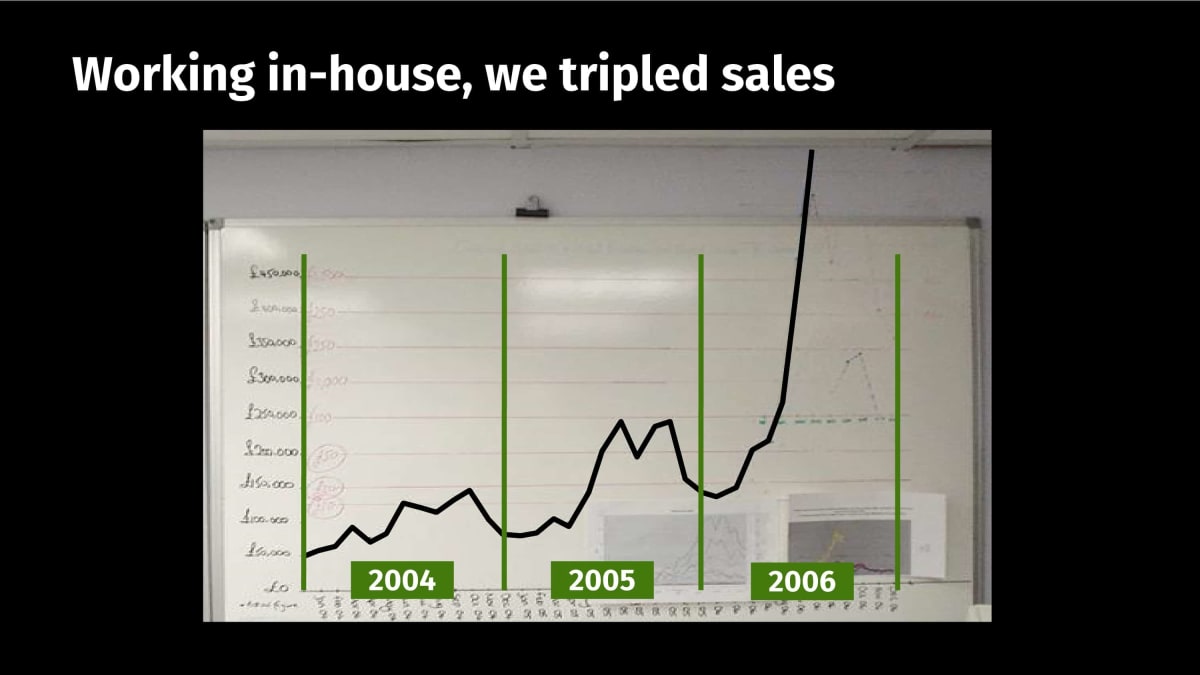
My cofounder, Ben Jesson, and I used to work in-house for a company that sold cellphones to international travelers. This was the graph they had on the wall for the staff compensation program—the end-of-year bonuses. It was a travel business, so it peaked every summer and dropped again in the winter.
By the end of 2005, we didn’t know what else we could do to grow the business. We were number one in the search engine rankings for all of the industry’s main keywords, and we’d had loads of PR; we’d been in almost every travel magazine. It was at the end of 2005 when we discovered that A/B testing—and in particular, multivariate testing—could be carried out on websites.
Because of my scientific background, it seemed like an obviously good thing to do, because when you’re running large-scale industrial processes, A/B testing is the way you improve them. That’s how manufacturing works. And so, we started doing A/B testing on our website.
We tripled the company’s revenues to about $9 million in the following 12 months. And then, by 2007, we had doubled it again. We realized that this works, that it’s amazingly powerful. In doing so, we discovered we’d developed new techniques and a different approach to website improvement. It all involved A/B testing. And it all involved copywriting.
So for the rest of this talk, I’m going to talk about how you can become a copywriter yourself.
The title of this talk, “How You Can Beat Most Professional Copywriters,” may sound far-fetched, but you have to remember that most people who have the word “copywriter” on their business card aren’t copywriters by our definition. By our definition, if someone has never won an A/B test, then we would not call them a copywriter, because an A/B test is the way to measure that your copy has beaten the control—the existing version.
If someone calls themselves a copywriter but can’t show any evidence that they’ve won A/B tests, it’s like someone calling themselves a salesperson but can’t provide you with any evidence they’ve ever generated sales. Or someone calling themselves a golfer, but not only have they never won a game of golf, but they also have never even played against someone at golf. What I’m going to show you is enough to make you surprisingly sophisticated at copywriting.
We wrote an article about what we had been doing, and it went viral. Ours was one of the fastest-growing websites in the world that week, according to Amazon’s Alexa reports. The next day, Google contacted us out of the blue and asked, “What are your plans?” They invited us to become the first worldwide authorized partner for Google Website Optimizer, which was Google’s A/B testing tool.
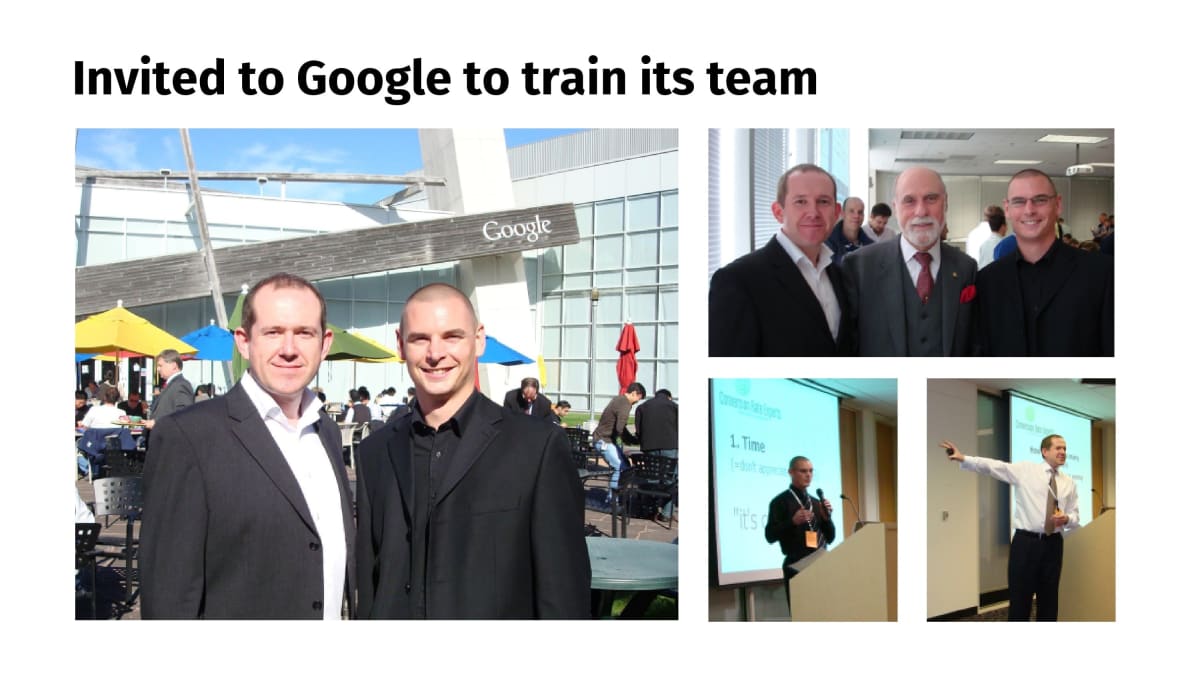
We didn’t plan to create a consultancy, but that’s where things led. Nowadays, we carry out A/B tests and design pages for some of the world’s most sophisticated companies—companies like Apple, Google, Facebook, and Amazon.
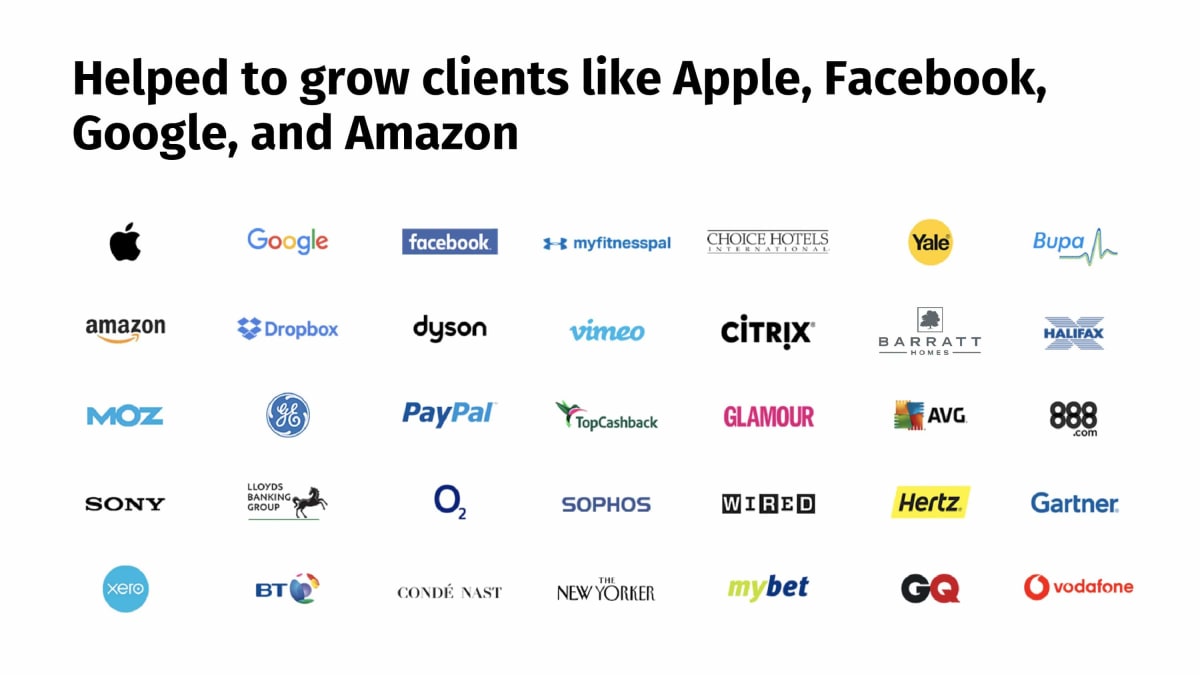
We’ve worked in almost every industry. We have sold almost everything. And it’s reassuring that whatever you sell, the advice in this talk will be applicable, and really, really useful.
(I won’t go into details, but on our “Clients and Results” page, we have 109 video testimonials from our clients telling the stories of how conversion rate optimization—CRO—has radically grown their businesses, often by more than double.)
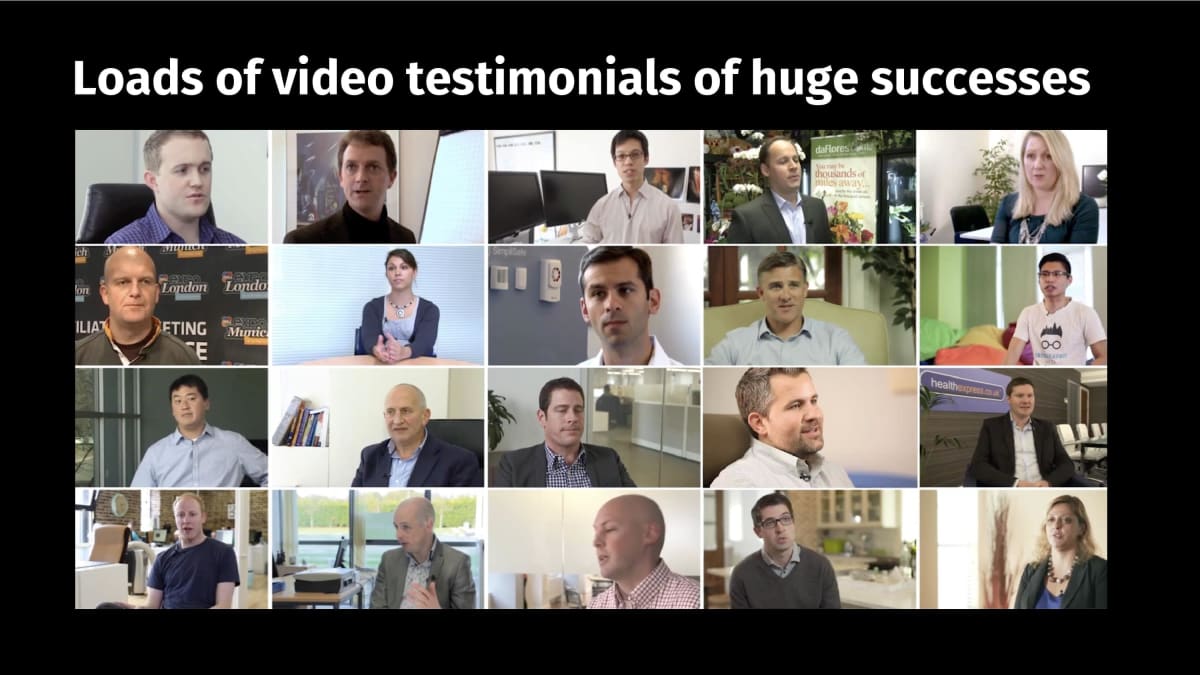
Then most people first find out about copywriting, they want to know: What are the words that sell?
There’s a book called Words That Sell that contains a big list of words that are useful for copywriters—like a copywriting thesaurus. The book has its uses, but that’s not really what copywriting is about. You might also buy the book, More Words That Sell, but that’s not what it’s about either. Nor is it Phrases That Sell, or Tested Sentences That Sell.
There are two skills to copywriting, and they aren’t really about the words.
- Skill one is about becoming able to sell the product face-to-face.
- Skill two is being able to take that knowledge and turn it into writing.
The rest of my talk is going to be mainly about these two steps.
Step One: Selling face-to-face
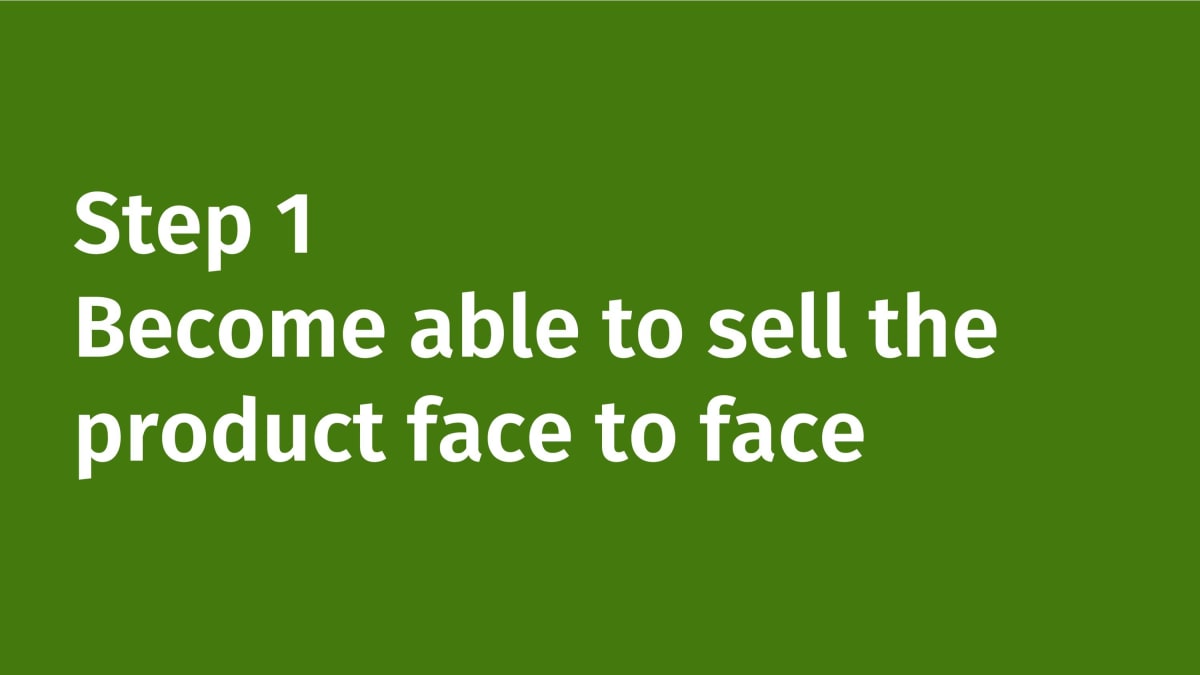
Step one, which I’m talking about now—becoming able to sell the product face-to-face—that’s the first thing you need to be able to do, and here’s why: It’s because your “robot salesperson,” which is what your website is, will be no better than its creator.
In other words, if you can’t sell the product face to face, if you can’t sell it to someone in person, then you don’t stand a chance of creating a page that will sell it because you don’t know all the things you need to say in order to sell. There’s no way you can create a page that does it automatically for you.
Have ready answers to common objections
Here’s a great example: With every client we work on, whatever it is, one of the things we always do is find someone—usually within the client’s organization, often someone in customer support—someone who can sell the product themselves.
In this example, we were working on a page for an electrical device, and we went to a store where they sold them. And this lady was amazingly knowledgeable; she sold about five of them per week. We showed her the client’s page and asked, “How would you improve this page?”
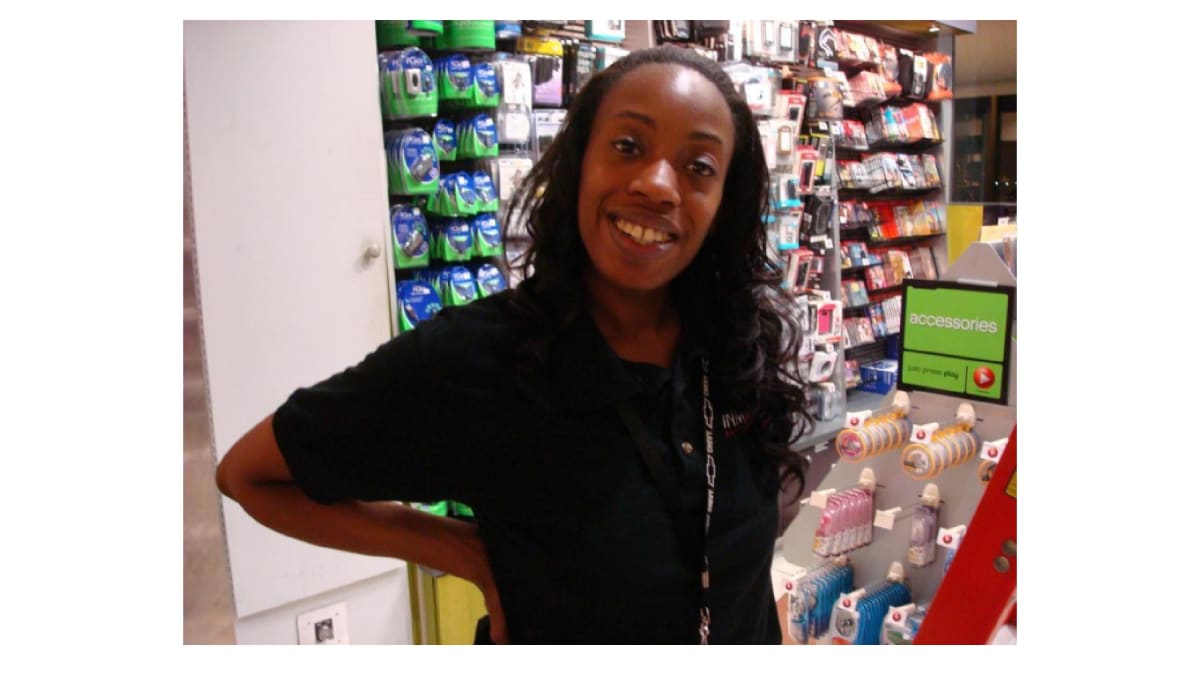
She replied, “When we started selling these electronic devices, the first thing I used to do is…people, our prospects, the visitors to the store used to ask us questions, so I would look on [the company’s] website for the answers and the website wouldn’t have them.” She then listed about 22 different things that customers often asked and needed to know before they would buy, none of which were on the client’s actual website.
Can you see how the website lacked the information a real person would need to sell these? She knew what those things were, and she effectively gave us a list of 22 common objections—and the counter objections she had come up with—that answered their questions and allowed her to sell the product.
That was ready-made copywriting gold. It didn’t come from a book of magic words; it was real, genuine things a customer needs in order to take action.
Become the customer
The second part of learning to sell face-to-face is to become the customer yourself. Whatever we sell, we insist that our team members go and buy it themselves. We reimburse them for it. (Just between us, we’ve bought a whole load of unusual things from clients this way.)
What we always do is start on the web, research it. Don’t just go to the client’s website, but also shop around like you would in real life.
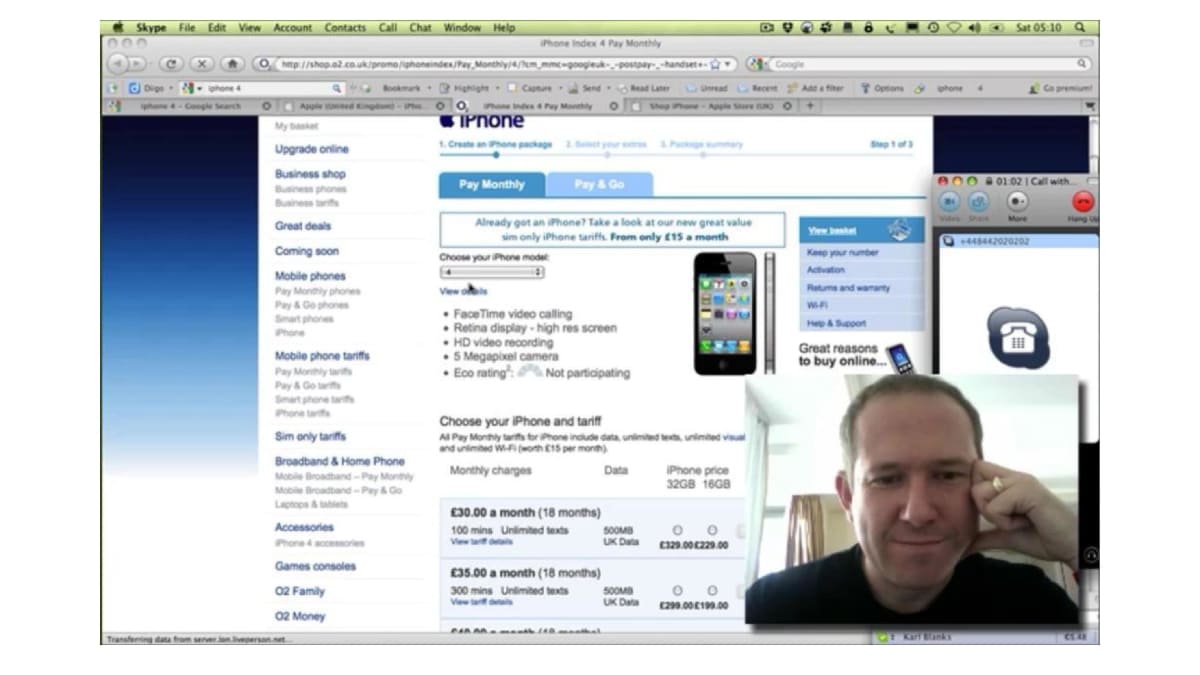
Record yourself with Camtasia—or if you’re on a Mac, ScreenFlow—so you’ll have a record of the shopping experience. We often like to include our own faces on the recording, because you can even see your own emotions at the times when you’re getting frustrated. You can zoom back through this at a later date and watch the movie to remind yourself of what different websites looked like and what the information was. It’s a rapid way of being able to work your way through different funnels.
If you have any questions, and if you normally pick up the phone to call customer support, do that and use Skype, so you have a record of that experience as well. It’s really useful for you to become the customer this way because you need to be able to understand the customer’s views. How crazy is it to think of selling something if you haven’t been the customer yourself?
Then, when you’ve bought it, use the product. Here’s a photo of my cofounder, Ben. One weekend, we were working for a company that sold sheds, and we asked, within our company, which of us most needed a shed. Ben didn’t need a shed, but I guess he was the person who was least reluctant to buy one and set it up, so yeah.

He ordered it, he had it delivered, he assembled it. And in doing so, one thing he discovered was that all of the panels of the shed, which had been delivered on the front lawn, were too large to fit through the house—which he had to do—and they damaged his walls on the way through.
So, he reported back to the client. They redesigned their sheds so that now, all of their shed panels are small enough to fit through a standard house doorway.
If you think about the improvement in customer satisfaction (and in Net Promoter Score) for making what seems like quite an obscure change, it’ll be huge. With all of these little things, as you’re using the products, you’ll learn different aspects you were unaware of until you were actually the customer.
Get honest feedback
The next thing you need to do is, on whichever page you’re improving, have an on-page survey asking questions. In particular, ask why…here’s one from one of our pages. It’s from our Learning Zone page where we ask, “Did you decide to download our PDFs? Please let us know why or why not. You can be brutally honest. We love feedback.”
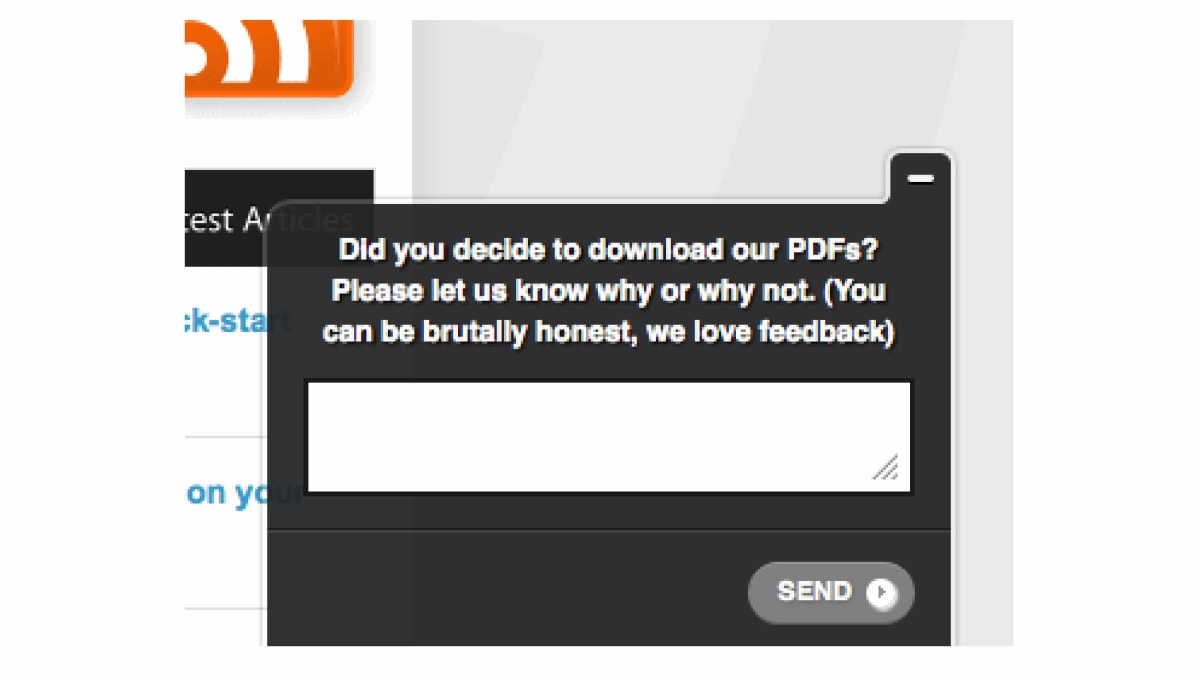
It almost feels like cheating, doesn’t it? Where you can effectively just ask, “How can we improve this page?” or, “Let us know why you won’t take action.”
With so many of the pages on our website and our clients’ websites, we have these surveys. We don’t run them forever—only for the time it takes to gather the information we need. Then you can iteratively improve the page, and when you see an objection coming up several times, fix that objection.
This survey tool is called Qualaroo, and we find it really useful for finding out specifically why visitors and customers aren’t taking action.
Create a mental shopping list
The next thing to consider is the mental shopping list. This is a list of all the things a prospect needs to think about by the time they take action.
Here is a basic list just as an example. (There’ll be lots more-detailed ones for each product or website you’re working on.) So here, for example, they need to think…
- “This website looks relevant, and it’ll satisfy my visitor intention.”
- “I believe this is the best website of its type, so I won’t be considering the competitors (which include ‘doing nothing’ and ‘ordering offline’).”
- “I can easily find what I’m looking for.”
- “I can understand which product is best for me because the website makes clear recommendations.”
- “I believe this type of product is what I need.”
- “I believe this particular product is what I need.
- “I believe the claims the website is making about the company and their products because they’re supported with proof.”
- “All of my miscellaneous product-specific objections have been overcome.”
- “I found the whole experience pleasurable, and I’d happily do it again.”
…and you can write those all out.
What you’ll find is that each website has different bottlenecks—different questions that aren’t being answered at the moment. So you need to create this list because you need to identify…
- On which stages, which paths, and which aspects of the website are the customers or visitors getting stuck.
- Which of these questions your website isn’t currently answering.
→ To recap so far
Don’t start writing until…
- You know everything about the product.
- You’ve bought and used the product with your own money.
- You can understand why people buy it.
- You could sell it to yourself or your friends—because if you couldn’t sell it to yourself, then you don’t stand a chance of selling it to other people.
- Know all the objections and have great counter objections to them.
- You’ve gathered proof to support all of your claims. And speaking of that…
Gather a legal dossier
Imagine that you’re gathering proof—you’re essentially gathering a legal dossier to prove that the product and the website are the best. That’s a good way to think of it.
It’s not marketing, you know, this idea that it’ll work to just come up with loads of marketing buzzwords. That’s not what converts. Visitors are only converted with proof.
When I say you need to sell it face-to-face, that doesn’t mean you need to become a sleazy salesperson. That’s exactly what it’s not about. It’s about understanding all the things you’d need to say to persuade someone—all the things the visitor needs to know before they can take action. All those facts exist somewhere out in the world, and you need to get out and learn them.
So that’s the first step of the two aspects of copywriting. The second one is writing it down.
Turning it all into writing
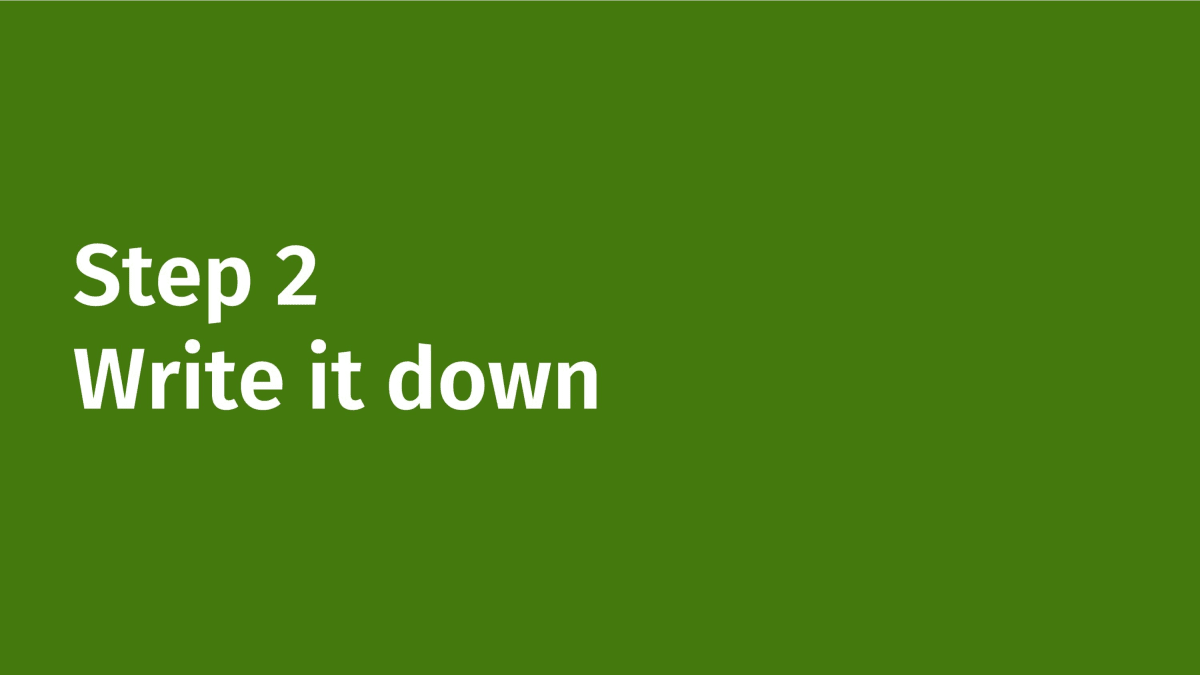
Most people prefer only one of the two steps. People who love Skill One, selling, often shy away from writing. People who enjoy Skill Two, writing, are often uncomfortable with the selling part.
Few people are comfortable with both.
One of the secrets of becoming a great copywriter is that whichever one of the two steps you’re not comfortable with, push yourself out of your comfort zone.
If you can have the self-discipline to do whichever step you find least comfortable, and grow in that area, then you can become what’s quite a rare breed. There aren’t enough good copywriters around.
Writing turns a genius into a moron
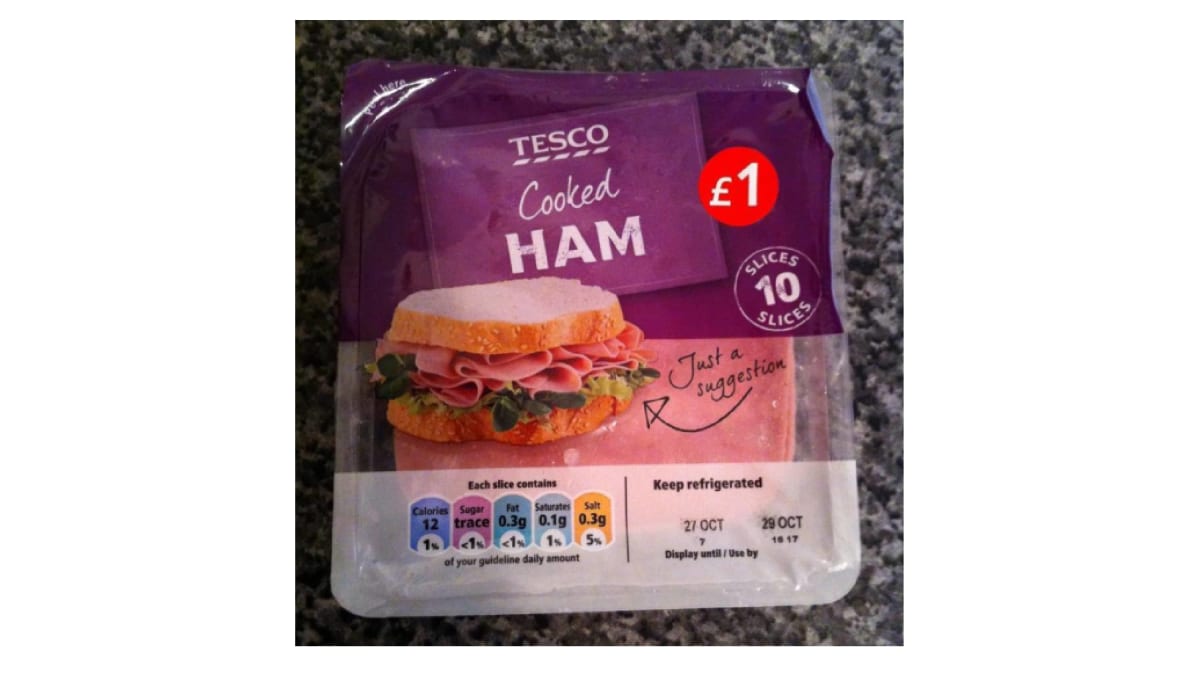
Here’s a packet of ham I bought from Tesco a few months ago. Pretty much the only sales copy on the whole package is where it says, “Just a Suggestion.”
Imagine if you went into a supermarket and it had a deli counter, and there was a person there serving up the ham. You order some, and they give you a packet of ham. Could you imagine the situation where you say, “Oh, thank you very much,” and you’re about to walk away, and the person says, “Hang on…just a suggestion.”
“Oh yeah, what’s that?”
“Well, you could make a sandwich out of that.”
“Yes, I know that. Is that all?”
“Well, maybe you’d also want not to bother unfolding the ham properly. Or possibly add a bit of lettuce.”
“…But yeah, I knew that.”
That wouldn’t happen, would it? A real person would never say that in real life. They’d never stop you and say, “Just a suggestion.” But for some weird reason, the act of writing turns many a genius into a moron.
I think it has something to do with the way people are taught to write at school—there’s a disconnect. So someone who’d never dream of saying, “Just a suggestion…” when they’re selling ham face-to-face will be happy to write it on a packet, not realizing what a strange thing that is to say.
Write like a human

One of the big things about learning to be a good copywriter is to write like a human. Write in the same way you’d speak to someone in real life.
It’s hard because, at school, a lot of how you’re taught to write involves the opposite. It involves writing in a way you would never normally speak. So you have to unlearn a lot of skills and write things down in the same way you’d speak to a real person.
How do you do this? One easy way is to record yourself. Get a recorder and record yourself speaking, saying whatever it is you would say if you were face-to-face with someone.
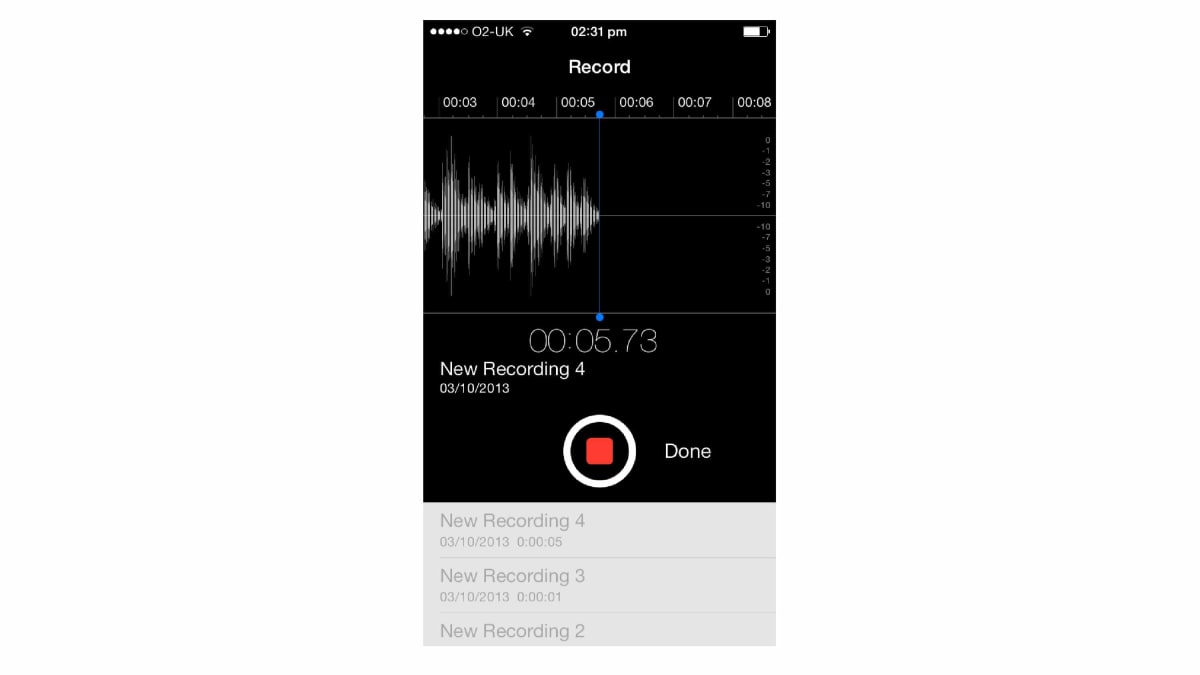
Imagine someone walked through the door and said, “You know, I’ve just searched Google for these keywords. Over to you—what would you say to me?” And speak out what you would say to a real person who was calling in, then get that transcribed and analyze exactly what it is, maybe tidy it up. Make sure that all of the things you would say in real life are the things you’re saying on your website.
We often say the following to website owners: “I’m going to pretend to be a visitor, and you have to sell to me, but you’re only allowed to sell by saying the words on your website.” Most people are embarrassed to say the words on their website to a real person because that’s the point they realize the disconnect—that they would never use those words in real life.
Use the right number of words
People often say, “How long should a page be? Do people read these days? How many words should we be using on a page?” What we say is, you need to use at least as many words as you’d use when selling face-to-face.
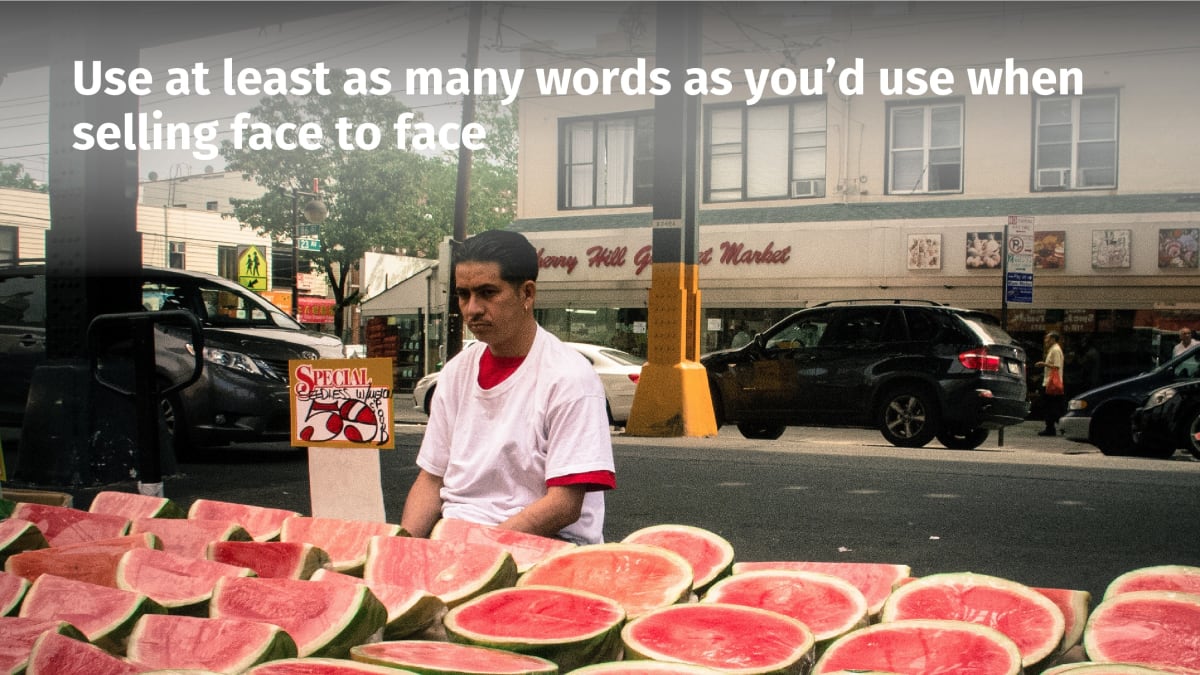
Now, for some products—like this guy here selling watermelons—then the answer is, “Probably not very many words at all.” In fact, he looks in a bit of a bad mood. He looks like he might not speak very much at all.
But if you’re selling a CRM system, you wouldn’t dream of selling it face-to-face without at least three visits to the client’s building and maybe to have three one-hour sessions, then that’s a lot of words. Your page needs to contain at least as many words as that.
In many cases, that means your page will be much longer than you’re comfortable with. But look at examples of websites or pages that really convert, and companies that do carry out A/B testing. Here’s Amazon’s page for the Kindle. If you printed that page out, it would be 19 feet tall. That’s over three David Hasselhoffs tall!
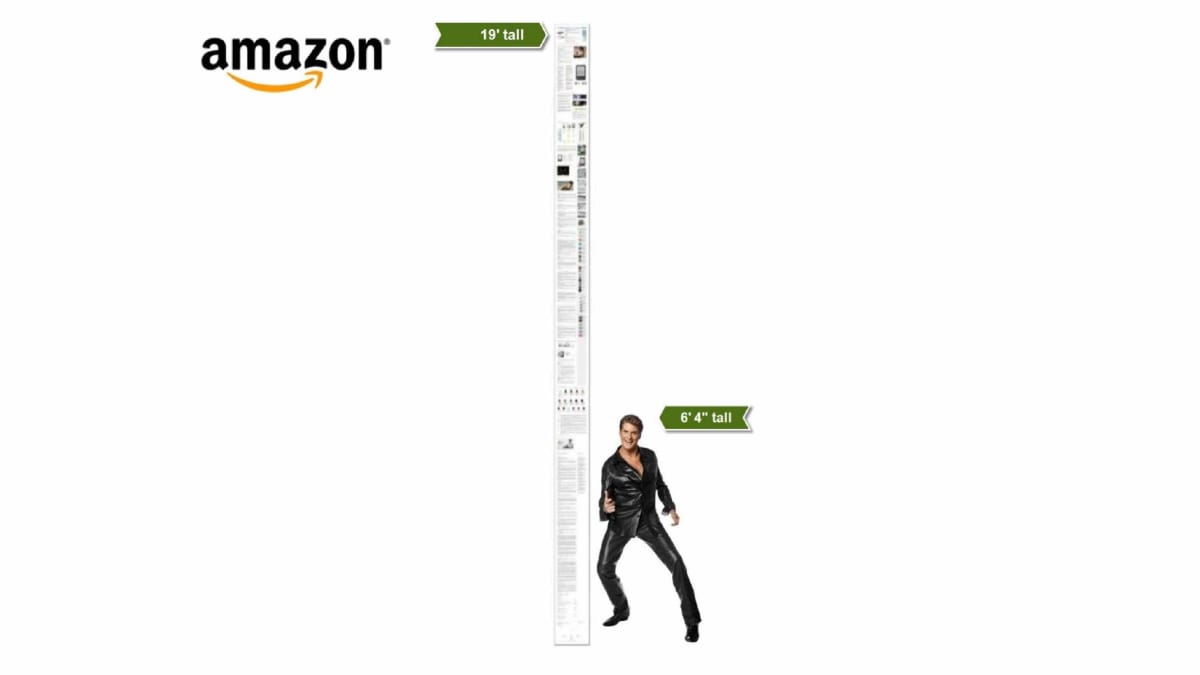
I know I said just now that you need to use as many words as you would in real life. But actually, you have to use more words, because in real life you can adjust what you say based on the person’s questions.
On a website, however, you have to anticipate all the possible common questions and address them ahead of time. So typically, you’ll need at least that many words, and maybe more.
Now, this doesn’t mean I’m recommending that you waffle—quite the opposite. You need to be as concise as possible—like really, really concise. But even when you are concise, you’ll still find that your pages have to be long because most things require a lot of words to sell them.
Resources for writing well
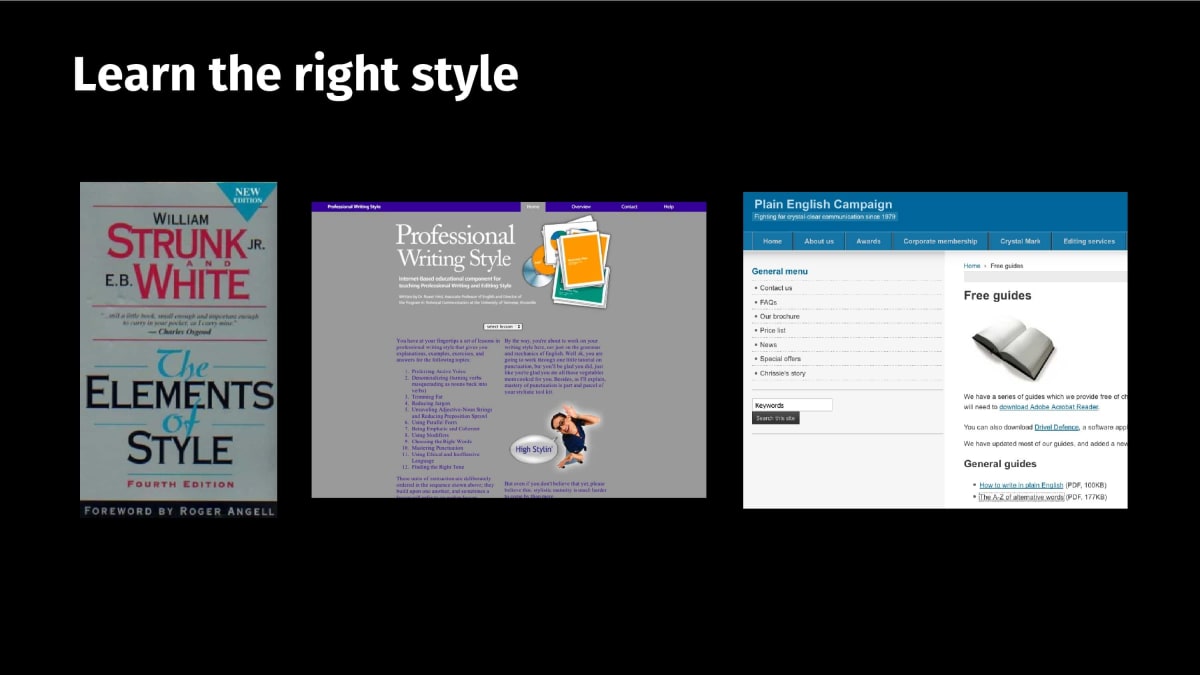
Next, we’ll take a look at how to learn grammar and the mechanics of writing and “style” as they call it. Here are three great resources:
- The left-hand one is a concise book called The Elements of Style by Strunk & White. A lot of things in there are controversial, but the second half of the book is an excellent description of what good writing is. It’s very useful.
- The middle one is the Professional Writing Style website, which is an excellent guide to some very mechanical things you can do to create better sentences.
- The next one is the Plain English Campaign, which has some great guides on how to write in plain English. To some extent, what the Plain English Campaign PDFs do is permit you to unpick lots of the things you learned at school in English classes.
Read it aloud

Next, when you’re writing, make sure that whatever you write, you get at least one person to read it out loud to you. You need to have someone who can read the whole thing. As they are speaking, you need to listen for … where do they get confused, where do they pause, where do they hesitate, where do they misread something? That’s valuable.
We do it for everything we ever write. Every single blog post gets read out loud by at least one person. It takes time, but it’s worth it because it’s so valuable.
You might think, “Do I have time for this?” But if your page is important enough that maybe 10,000 people are going to see it, perhaps a hundred thousand people are going to see it, then the answer is, “Yes.” Ten minutes of your time can save hours of your readers’ time.
Structuring a landing page for conversion
Now, I’m going to go through a template for a highly converting landing page.
There are many different ways you can structure a sales page. What I’m giving here is a very versatile, very robust format that will work with anything. If and when you become great at copywriting, you’ll get to the point where you’ll want to start trying different approaches, but this is the most robust, universally applicable template.
An enticing headline
The first thing you’ll have at the top of the page is a headline. Some people say a headline needs to contain the “three major benefits.” There are certainly over a hundred different formulae for what makes a good headline—different types of headlines depending on the situation. But the only rule is that the headline needs to make them want to read more.
Captivating opening sentences
Next, open with a sentence that makes them say, “That’s me.” If you’re selling CRM software, it’s not a bad idea to say at some point within the first sentence, “Are you looking for CRM software?” So people think, “Oh, I’m in the right place here. Yes, that’s exactly what I’m looking for.”
Use the inverted pyramid principle, which newspaper writers use. It’s where the first few sentences cover the whole of what you’re going to talk about, and then the writing becomes increasingly detailed as you go down. But don’t go too detailed too soon; you want to start broad and then get narrower.
Bullet points and graphics
Next, use bullet points with the main benefits and a clear next step. It’s a good idea to open up your page with bullets of the main benefits.
Ensure the graphical appearance of the page matches the website and connects to the target audience. Some people ask, “What graphics convert best?” but there’s no one answer. It’s all about signaling. You want to think, “What kind of website would the visitors like this to be? What kind of website would most reassure them?”—and then make it look like that type of website.
“Johnson Box” for easy navigation
It’s also a good idea to have what we call a “Johnson Box,” saying what you’ll get on the page.
The term Johnson Box is a word from direct mail. At the top of a direct mail letter, there’d be a table of contents—but a table of contents that both links to different sections and is also fascinating.
We find Johnson Boxes work really well on websites like the one we’re showing below, where you can see three irresistible fascinating links to each section so people can jump to the part that interests them most.
A Johnson Box effectively is a type of navigation, and some people now do it as a top navigation bar where when you click and it scrolls down the page for you. We find it to be an excellent, straightforward way to create a lengthy page that’s also navigable.
Here’s an example. Here’s our careers page, and you can see that we’ve labeled what the sections are. It starts at the top with a self-interest headline that gets the right people interested; the graphical appearance that matches the website; the Johnson Box you can see there, which is all the bullet points for the different sections so people can skip to what they want; and then here, you can see very early on, we’ve included bullet points with the main benefits.
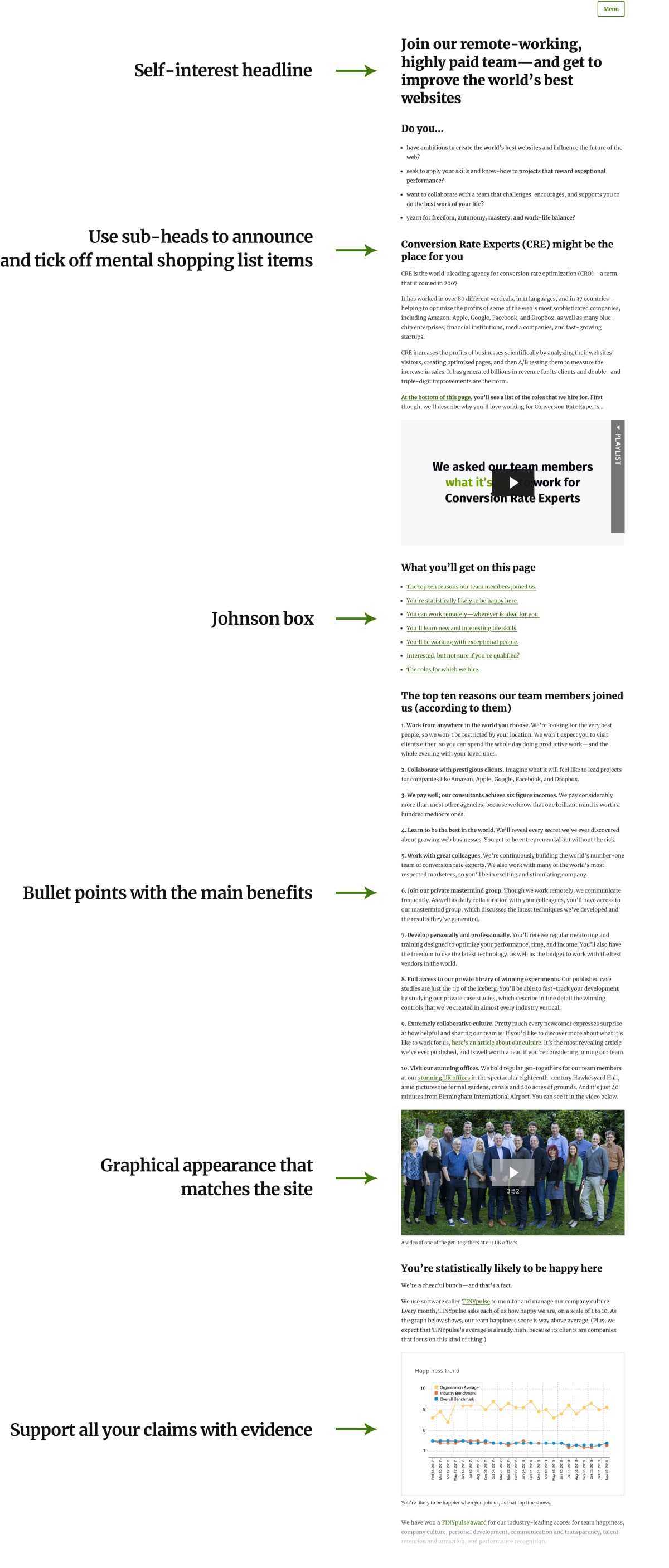
Split the page into sections
You’ve got their attention, but you still need to make every single word count. So, use subheads to announce and sell each section. Have sections that check off each item on the prospect’s mental shopping list.
Before, I said you need to create a big list of all the things the visitor needs to think. Now is the time in your body copy to make sure that each section, every single one of those list items, needs to be checked off. And support all your claims with evidence.
Font size is important too. The page should be like climbing into a hot tub of text. Start large and then gradually step down the font size. Don’t go from a large headline straight into a small body copy. It’s much better to step it down in terms of headline size.
And again, back on that page I mentioned before, you can see we’ve got the subheads, each of which addresses a different aspect we want to check off in the prospect’s mental shopping list. And there, you can see an example of us supporting the claims with evidence.
We always wanted to have a section on how you’ll be happy working for us, but it was only once we got the actual data to prove that consultants at CRE are happy that we included this section. Saying you’ll be happy working here is nothing unless you’ve got proof. And so, there’s the proof based on the survey data we capture compared to the industry average.
And finally, add a call to action
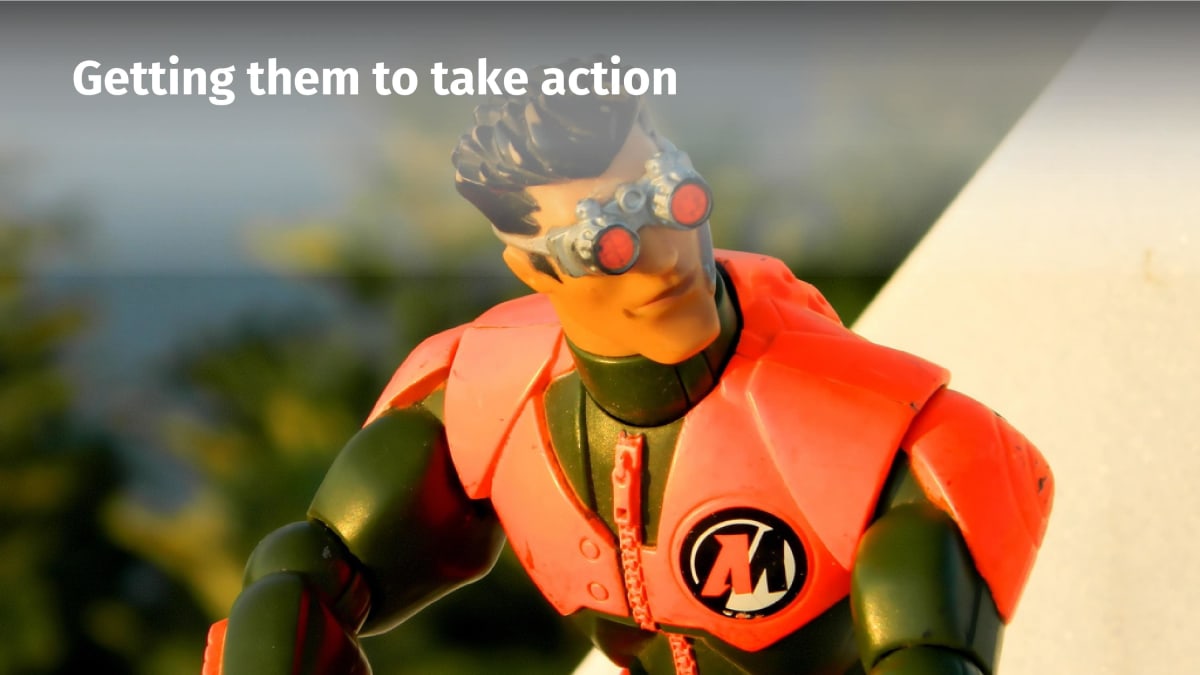
The final part of your page is to get them to take action. It’s really, really important that you get the call-to-action right because that’s the point at which you’re getting them to do something. That’s the point at which they have to make a decision.
Here’s what your offer and call-to-action should do.
First, it needs to summarize the benefits. Because some people will have skimmed around the page or even just scrolled straight to the bottom. By summarizing the benefits, you make sure they’re reminded (or even learning for the first time) what they’re getting.
Then, present the offer, and justify the price to make them realize that what you offer is worth more than what you want in return. What you want in return may be money, but it also might be their email address, for them to submit a lead, or to tell-a-friend.
Two easy ways to make them act right now:
- Risk reduction. We could talk for at least an hour about risk reduction strategies. There are many ways to reduce risk. In summary: (i) Work out ways to make the risk lower, and (ii) below the call-to-action, explain why the risk is low.
- An incentive for prompt action. Look within your company for reasons for urgency. Why should the visitor take action urgently? What’s the scarcity? And then be sure to mention it at that point. That’s the point at which people are hovering, wondering whether to go away or do something now.
That’s the end of the template.
The things most likely to increase profits
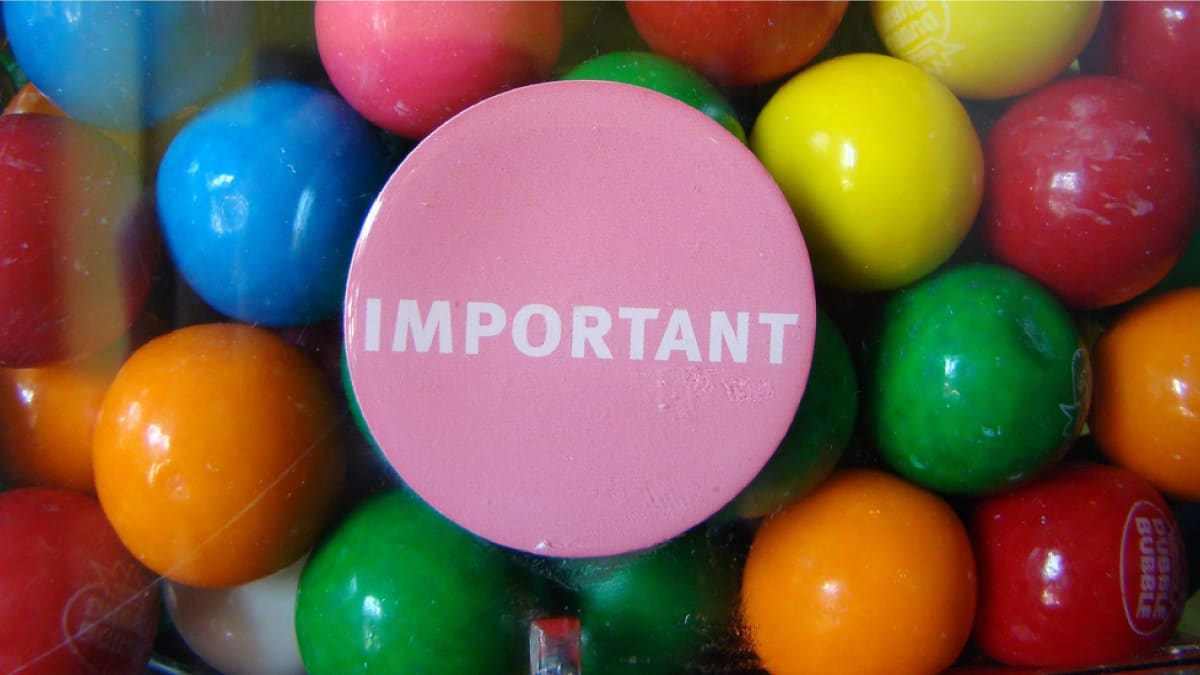
People often ask us, “What are the most important things? What are the top things I should test on my website? I’ve got my A/B testing software. What should I do first?”
That’s a hard question to answer because it depends on your situation—it’s like saying “What part of my car should I repair”—but here are five of the most important things, the ones that tend to get wins in almost all cases:
- The angle.
- The things that get looked at first.
- The offer and calls to action.
- The weakest aspects of your current website, whatever they are.
- The proof.
I’ll go through them in turn.
The angle
First, here’s an excellent example of what I mean by angle. Imagine you’re writing a page that sells fertilizer to homeowners. Now, here’s what the legendary copywriter Robert Collier wrote as the opening of a sales letter:
“With your permission, I’m going to make an analysis of the soil of your lawn to determine, at my own risk and expense, what elements are lacking in it, what you need for stronger, healthier, more closely grown turf.”
Can you see that that paragraph is not about special magical words; it’s about what he’s saying.
He’s not saying, “My fertilizer has the following three benefits…” He’s saying, “Free of charge, I’m going to carry out an analysis of your soil and tell you some interesting facts about it and diagnose what you need.” That’s a whole different angle, a whole different approach, a whole different meaning. Great copywriting lives at the level of meaning.
Imagine you were selling grass seed face-to-face, and someone says they aren’t interested. You might retreat and think, “I’m going to try once more, but this time I’m going to enter the conversation with a different angle, a different way of opening the conversation.” That’s what we mean by angle. It’s a different approach into the conversation.
The new angle might be that you start talking about the guarantee. It might be that you open with proof. It might be that you open by talking about the offer and how there’s no risk. It might be that you open by educating them. What matters is that you’re saying something completely different.
What they’re looking at
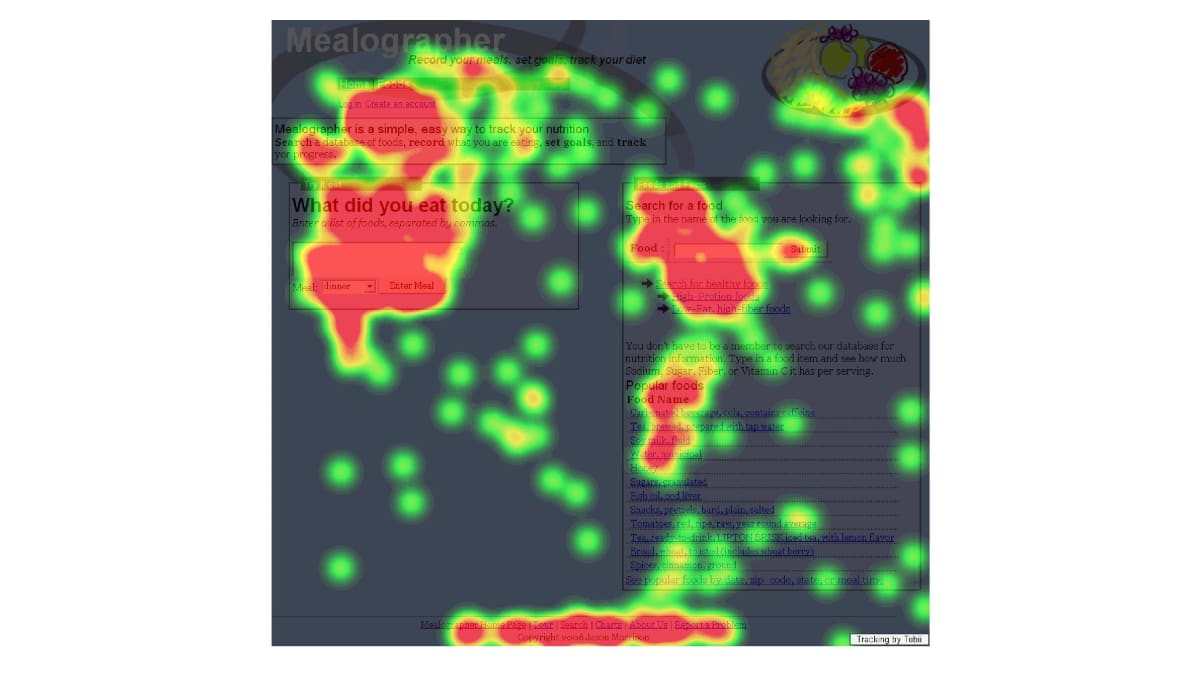
In eye-tracking report would show you exactly what your visitors are looking at. Even when you have no eye-tracking data, you must be aware of the concept, and focus on those parts of the page that will be viewed most. In particular, focus “above the fold”—the top of the page—because that’s what people can’t help but see first. In particular, focus on headlines, images, and anything that’s large and stands out (“pops’)—because those things tend to be looked at first.
The offer and the call to action
You can change what you’re offering in several different ways.
First, you can look at the long-term strategy for pricing. You may want to make as much money as quickly as possible (or whatever the goal of your company is) but think long-term. Think of Amazon, which has the goal of keeping customers for life. So think of your long-term strategy—not only to win this first A/B test.
Common winning offers are:
- Make the initial purchase a no-brainer.
- Make the “headline offer” irresistibly appealing.
- Consider stripping down the features of your service, then charging for extras.
- If you can’t make it free, make it seem cheaper. There are lots of ways to do this. For example, start with a lower commitment. Or even charge as a monthly payment, which works so often.
- Upsell and cross-sell. Think of other things your visitors will want to buy or will be buying at the same time.
- Add premiums and incentives. You could give away a free report, which doesn’t have any unit costs. You pay only for the one-off cost of creating the report.
- Think of ways of bundling or unbundling other products or other services.
There are many ways to package up your product without having to change what it is—to make it more appealing to the prospect.
Find your website’s weak points
Next, identify the weakest parts of your website. I won’t go into detail here, because there are so many different techniques. (Our best-selling book, Making Websites Win describes them all.) Most websites are weak in the following ways:
- Proof. The slide shows just three examples of effective proof, but there are many ways to bolster the proof of your claims.
- Social proof. Anything that shows you’re growing quickly, or that other people in your prospects’ situation are making the same decision you want your prospects to make.
- Testimonials. Show examples of happy, successful customers.
Testimonials can be from customers, but it helps if they have authority, popularity, credibility, and influence. Celebrities, for example, have many of those. One amusing example is that in the UK, Weetabix breakfast cereal is endorsed by the Queen. It has the Queen’s stamp of approval, which affirms that the Queen thinks it’s a good breakfast cereal. Now that’s a great proof element. (The Queen has also given our company her approval, twice.)
Endorsements can also come from the media, online and offline. What credibility does your company have, and what proof do you have in that respect?
A good thing you can do right now is, on your computer, take a second to create a new folder and call it “Proof.” From then on, whenever you see a good press clipping, or when a customer says something nice, file it in your “Proof” folder. Then, when you create a landing page, it’s really useful that all your proof is in one place.
Most companies, when we start asking them for the proof, say, “Oh, wait. Yes, we were in the news, but we can’t find a copy.” They don’t have an organized system for storing and retrieving proof.
Hiring copywriters
If you’d prefer to hire a copywriter, rather than learn to do it yourself, the following tips should be useful.
First, find someone with a track record of getting wins. In particular, if this is the Olympics of writing, don’t trust it to someone who has never won—or even run—a race. Just because someone has “copywriter” written on their business card doesn’t mean they’ve ever had a win.
Next, once you’ve hired them, ensure their work is A/B tested. If someone writes copy and is trying to increase sales, why would they not want to A/B test their version against the control to learn if it worked? Why would they not want to know the truth? We insist on A/B testing all the changes we make to our clients’ websites—even if they don’t ask us to—because we want to know what works. Every great copywriter wants to know the truth. There’s no other way to become great.
Ensure the copywriter follows the two-step process I’ve described: 1) learn how to sell the product, and 2) use craft to put the message into writing. So hire someone who can sell and can write.
How do you know if they can sell? A good question is, would you buy from them? Are they the type of person you’d buy from? You aren’t looking for a sleazy salesperson; you want someone who’s thoughtful and methodical about how they persuade.”
How do you know if they can write? See if you can effortlessly understand what they write. Do you enjoy reading their writing? If you get bored reading their application form, don’t feel guilty deleting it—because if they can’t keep your attention in an application form, they won’t be able to keep your visitors’ attention.
The best copywriters in our company—and many that we didn’t hire—had fascinating application forms. We were looking forward to meeting them. There was one that made me laugh so much I literally had tears running down my face; it was hilariously funny. And that’s a good thing.
Thank you for joining us
That’s all for now. To discover more, visit our Learning Zone or get a copy of our best-selling book, Making Websites Win.
And whether you outsource copywriting or do it yourself, make sure it happens. Because it’s really, really important.
We know of no better way of growing a company.
How much did you like this article?
What’s your goal today?
1. Hire us to grow your company
We’ve generated hundreds of millions for our clients, using our unique CRE Methodology™. To discover how we can help grow your business:
- Read our case studies, client success stories, and video testimonials.
- Learn about us, and our unique values, beliefs and quirks.
- Visit our “Services” page to see the process by which we assess whether we’re a good fit for each other.
- Schedule your FREE website strategy session with one of our renowned experts.
Schedule your FREE strategy session
2. Learn how to do conversion
Download a free copy of our Amazon #1 best-selling book, Making Websites Win, recommended by Google, Facebook, Microsoft, Moz, Econsultancy, and many more industry leaders. You’ll also be subscribed to our email newsletter and notified whenever we publish new articles or have something interesting to share.
Browse hundreds of articles, containing an amazing number of useful tools and techniques. Many readers tell us they have doubled their sales by following the advice in these articles.
Download a free copy of our best-selling book
3. Join our team
If you want to join our team—or discover why our team members love working with us—then see our “Careers” page.
4. Contact us
We help businesses worldwide, so get in touch!
© 2025 Conversion Rate Experts Limited. All rights reserved.










